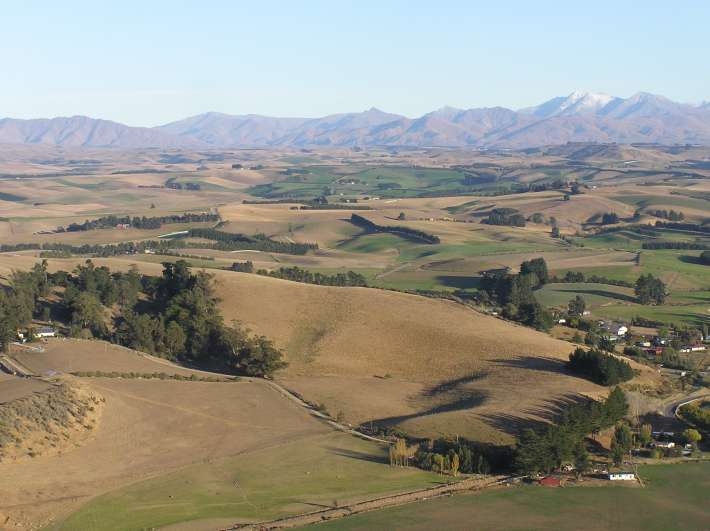
DAIRY
The big dry is settling in.
North Island regions have received 20% less rain in January than the norm, and also hot conditions but better feed covers in the south.
While national milk flows were tracking 8% ahead in November, feed volumes reduced in following two months and production will be falling behind targets.
Summer management skills of longer rotations, forage crops, once a day milking, and early culling of inefficient cows are now being enacted as operators adapt to the dry.
Southland, Taranaki and irrigated areas of the South Island are having a good production season and the dairy industry applauded the recent $80 million support for new irrigation schemes by the government.
Positive news for the industry was seen with a big rise in dairy farm sales for 2012 and China cutting milk tariffs on infant milk formulae.
But challenges remain as ever rising costs eat away at profits, and a Morningstar analysis reports the fair value estimate of the Fonterra shareholders fund is overvalued at its present market rate of over $7 a unit.
The dairy sectors goals of environmental sustainability and meeting those challenges through science, were setback with the withdrawal of nitrate inhibitors for on farm use because of milk contamination.
The negative publicity this issue has aroused worldwide is out of perspective, but reinforces how important food safety is to consumers. What also has annoyed some customers is the four month delay by Fonterra and the government in announcing this contamination of milk products.
LAMB
The dry conditions are putting greater pressure on poor lamb prices by removing the opportunity for farmers to compensate low returns with heavier weights. While schedules stabilised this week, December processing figures showed North Island farmers killed many more lambs and ewes earlier than last year as they ran out of feed and tried to beat falling prices.
Reports from the market reveal January demand is picking up but caution remains and many customers were only purchasing hand to mouth to minimize the risk of carrying too much stock.
High valued middle cuts are still slow to move but lower valued products lifted in demand especially to China.
However amid all this gloom, murmurings have been heard of better cooperation between exporters on lamb marketing which will give sheep farmers some hope for more sustainable pricing in the future.
This is now being seen in the recently announced $65 million PGP project in which six of the main processing players have invested to "ensure that red meat producers consistently have access to and are able to effectively use the best-available farm and business management practices". A Government investment of $32 mln to support this project is another welcome financial boost for sheep and beef farmers whose profitability is at risk.
WOOL
Last weeks sale momentum was lost at this weeks auction as all indicators dropped and big passings returned at the south island sale. Indicator prices fell by 6-13c/kg for crossbred wool and by 25 cents for lambs wool.
The drop in sheep and wool prices has seen farmers move away from double or 8 month shearing and return to once a year as a way of saving costs but this has altered the sheep flows and caused shearing delays at peak times of year and no work for shearers at others.
BEEF
Schedules returned to their flat status as imported US prices weakened on the back of bigger Oceania supplies exceeding market demand.
The US drought continues to see increased cow slaughter but this is expected to ease by March and with hay stocks in that country the lowest for 56 years a turn around will be years in the making.
Local trade prices are flat near the seasons low, and in the south they have not moved for 2 months which is reflected in in prices for prime saleyard steers.
DEER
Another small schedule drop driven by cheaper hunted European game meat impacting on NZ farmed demand and causing caution in the market.
The sire stag sales saw very good clearances of specialist venison animals with venison breeding values and purchasers paid nearly $3500 per head for these genes.
Operators are now harvesting second cut velvet for the Chinese market and reports suggest pricing for most grades is between 5-10% ahead of last year.
AP Stag
Select chart tabs
2 Comments
This DCD fiasco can be squarely laid at the feet of the two major fertilizer companies in this country, Balance and Ravensdown. Fonterra have to track down the suppliers milk that is contaminated and stop collecting it. Fonterra should also fine the suppliers to the full amount allowable in the the supplier contracts. This must be fully covered by the fert companies fleecing it to the farmers. This industry does not need Irrisponsible companies selling untested non understood chemicles to farmers as fertilizers or part of.
That was what I was getting at - politely - when I asked whether CO had been at the Winton meeting.
I wasn't, but I'm told someone from Telford said we'd end up here, then representatives of those two blandly assured everyone that you just had to spread this magic elixir......
On the other side of the coin, there's a certain residual mind-set in the farming community - a lack of ability (or willingness?) to apply the lessons of the past to the decisions of the future.
"She swallowed the spider to catch the fly" ......kind of thing.
We welcome your comments below. If you are not already registered, please register to comment.
Remember we welcome robust, respectful and insightful debate. We don't welcome abusive or defamatory comments and will de-register those repeatedly making such comments. Our current comment policy is here.